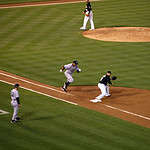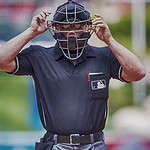OPS, or On-Base Plus Slugging, is a statistic used in baseball to measure a player’s overall offensive performance. It is calculated by adding a player’s on-base percentage (the percentage of times a player reaches base) and slugging percentage (the average number of bases a player earns per at-bat). OPS is considered by many to be a more comprehensive measure of a player’s offensive abilities than traditional statistics like batting average or home runs.
OPS was first introduced in the 1980s by baseball statistician and writer John Thorn. Since then, it has become a widely used metric among baseball analysts and fans alike. OPS is particularly useful in evaluating players who have different strengths and weaknesses in their offensive game. For example, a player with a high on-base percentage but low slugging percentage may have a similar OPS to a player with a low on-base percentage but high slugging percentage, even though their offensive styles are quite different.
What is OPS?
OPS stands for On-Base Plus Slugging, which is a statistic used in baseball to measure a player’s offensive performance. It combines two important metrics, On-Base Percentage (OBP) and Slugging Percentage (SLG), to create a context-neutral number that reflects a player’s overall offensive skills.
OBP measures how often a player reaches base, including hits, walks, and hit-by-pitches, while SLG measures a player’s power by weighing extra-base hits more heavily than singles. OPS simply adds these two numbers together to create a single statistic that reflects both a player’s ability to get on base and their ability to hit for extra bases.
Weighted On-Base Average (wOBA) is another statistic that is similar to OPS, but it is more advanced and takes into account the value of each type of offensive production. wOBA is considered a more accurate measure of offensive production than OPS, but OPS is still widely used and understood by many baseball fans and analysts.
Weighted Runs Created Plus (wRC+) is another statistic that is often used in conjunction with OPS to evaluate a player’s offensive performance. wRC+ adjusts for league average and park effects, allowing for a more accurate comparison of players across different eras and ballparks.
In general, a good OPS in baseball is considered to be around .800 or higher, although this can vary depending on the era and context in which a player is playing. It is important to note that OPS is just one measure of offensive performance and should be used in conjunction with other statistics and context to fully evaluate a player’s offensive skills.

OPS Formula
OPS, or On-base Plus Slugging, is a sabermetric hitting stat that combines a player’s on-base percentage (OBP) and slugging percentage (SLG) to give a more comprehensive view of their offensive production. The formula for calculating OPS is simple:
OPS = OBP + SLG
OBP represents a player’s ability to get on base and is calculated by dividing the total number of times a player reaches base (hits, walks, hit by pitch) by their total plate appearances. SLG, on the other hand, represents a player’s power and is calculated by dividing the total number of bases a player accumulates (singles, doubles, triples, home runs) by their total number of at-bats.
By combining these two metrics, OPS provides a more complete picture of a player’s offensive value than either OBP or SLG alone. A high OPS indicates a player who both gets on base frequently and hits for extra bases, while a low OPS suggests a player who struggles in one or both of these areas.
OPS has become an increasingly popular metric among baseball analysts and fans alike, as it provides a more nuanced view of a player’s offensive performance than traditional stats like batting average or home runs. While it is not a perfect stat and should be used in conjunction with other metrics and scouting reports, OPS is a valuable tool for evaluating a player’s hitting ability and overall offensive value.
OPS+
OPS+ is a variation of OPS that adjusts for park factors and league averages. It is designed to give a more accurate representation of a player’s offensive performance relative to the rest of the league.
OPS+ is calculated by taking a player’s OPS and adjusting it for the league’s OPS and the park factor of the player’s home ballpark. The formula is as follows:
OPS+ = 100 * (OPS / lgOPS) * (lgPA / PA)^(1/3) * PF
Where:
- OPS is the player’s on-base percentage plus slugging percentage
- lgOPS is the league’s OPS
- lgPA is the league’s plate appearances
- PA is the player’s plate appearances
- PF is the park factor of the player’s home ballpark

A player with an OPS+ of 100 is exactly average for the league. A player with an OPS+ above 100 is above average, while a player with an OPS+ below 100 is below average.
OPS+ is a useful tool for comparing players from different eras, as it adjusts for changes in league averages and park factors. For example, a player who played in a hitter-friendly ballpark in the 1920s would have a higher raw OPS than a player who played in a pitcher-friendly ballpark in the 1960s, but their OPS+ would give a more accurate comparison of their offensive abilities.
OPS+ is also useful for evaluating players who play in extreme pitcher’s parks, such as AT&T Park in San Francisco. Players who play in such parks will have lower raw OPS numbers due to the park’s dimensions and atmospheric conditions, but their OPS+ will adjust for these factors and give a more accurate representation of their offensive performance.
In summary, OPS+ is a valuable statistic for evaluating a player’s offensive performance relative to the rest of the league, while also adjusting for park factors and league averages.
Historical Significance of OPS
OPS, or On-base Plus Slugging, is a statistic used in baseball to measure a player’s offensive production. It is calculated by adding a player’s on-base percentage (OBP) and slugging percentage (SLG) together. OPS has become a widely used statistic in baseball, and its historical significance cannot be overstated.
One of the earliest players to have a high OPS was Babe Ruth. In 1920, Ruth posted an OPS of 1.379, which is still the highest single-season OPS in history. Ruth’s ability to get on base and hit for power revolutionized the game of baseball and set the standard for future players.
Another player who had a significant impact on the use of OPS was Ted Williams. Williams was known for his exceptional ability to get on base, and his career OBP of .482 is the highest in baseball history. Williams also had a career OPS of 1.116, which is the second-highest in history. Williams’ use of OPS as a measure of offensive production helped to popularize the statistic.
In more recent years, players like Barry Bonds, Miguel Cabrera, and Mike Trout have continued to push the boundaries of what is possible with OPS. Bonds holds the record for the highest career OPS at 1.051, while Cabrera and Trout have both posted seasons with OPS over 1.100.
OPS has also helped to shed light on lesser-known players who may not have received the recognition they deserved. Dick Allen, for example, had a career OPS of .912, which is higher than many Hall of Fame players. Paul Goldschmidt and Freddie Freeman are also current players who have consistently posted high OPS numbers and are considered some of the best hitters in the game.
In conclusion, OPS has become an essential statistic in baseball, and its historical significance cannot be overstated. From Babe Ruth to Barry Bonds, many of the game’s greatest players have used OPS as a measure of offensive production. As the game continues to evolve, OPS will undoubtedly remain a critical statistic for evaluating a player’s offensive abilities.
Conclusion
OPS is a valuable statistic in baseball that provides insight into a player’s overall offensive performance. It combines a player’s on-base percentage and slugging average to give a more complete picture of their ability to get on base and hit for extra bases.
In the MLB, OPS has become a widely used metric for evaluating players. It is especially useful for comparing players across different positions, as it takes into account the varying offensive demands of each position. For example, a catcher with a lower batting average but a higher slugging percentage may have a similar OPS to a first baseman with a higher batting average but a lower slugging percentage.
OPS is also a useful tool for predicting a player’s future performance. Players with consistently high OPS values are more likely to continue to perform well in the future, while those with consistently low OPS values may struggle to improve.
However, OPS is not a perfect statistic and should not be used as the sole measure of a player’s offensive ability. It does not take into account other important factors such as stolen bases, baserunning, and defensive ability. Additionally, it is important to consider a player’s individual strengths and weaknesses when evaluating their performance.
Overall, OPS is a valuable tool for evaluating a player’s offensive performance in baseball. When used in conjunction with other metrics such as wOBA and traditional stats like batting average and on-base percentage, it can provide a more complete picture of a player’s abilities at the plate. Whether you are a casual fan or a seasoned analyst, understanding OPS can help you better appreciate the game and the players who play it, such as the legendary Mike Trout.
- UCLA Softball: Let’s Go Bruins! - February 12, 2024
- Youth Softball Helmet Buying Guide: Keep ‘Em Safe - February 12, 2024
- Youth Softball Pants: Our Top Picks for Your Top Player - February 12, 2024








